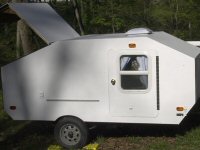I have used Dexter Axle information as they have really good information available on their web site, but the same information could be used for almost any make of axle.
The reason to pick a particular axle start angle is to get the right ride height on your trailer. This is shown as dimension 'B' below - the height to the top of the axle mounting bracket, which will usually be the height to the underside of the trailer frame.
The ride height 'B' is made up of two dimensions added together:
1) 'SLR' (static loaded radius), the distance from the ground to the center of the spindle/wheel/tire. As the tire squishes (technical term!) under load, this is less than the normal tire radius.
2) 'H', the height from the spindle to the top of the axle mounting bracket.
The SLR for tires 12" and up is given in this Dexter Wheel/Tire data pdf
The same info is given in this Goodyear Tire data web page and, yup, Dexter and Goodyear do give slightly different answers! Don't worry, I don't believe any of this info is more accurate than to the nearest 1/2 inch.
Most people seem to want to fit trailer tires which are several sizes bigger than they need to be - their tires will not be loaded anywhere near their capacity and so will not be 'squished' as much as these charts show. I think it is sensible to pick a SLR that is part way between the SLR and the normal radius in the tables, to allow for this.
To find out the height 'H', you need to look at the Dexter chart for the axle you will be using - go to the Torflex web page and click on Torflex Product Information. Here is the page for the #9 axle:
In the table, we can look up the dimension 'H' for different start angles. As with the tires, it's likely that the axle won't be loaded to its 'Full Load', so we could pick a figure that's part of the way from 'Full Load' to 'No Load' - for the first line of the chart above, we might pick an 'H' value of 4.0. Don't get caught out by the negative 'H' values in this chart, which mean the spindle is above the top of the mounting bracket.
Add together the 'SLR' and 'H' dimensions you've looked up and see if that gives you the ride height you want. If not, do it again for a different start angle - an Up start angle will give you a lower ride height than a Down start angle.
There is more than one style of axle mounting brackets and which one you chose will affect the ride height. For the Dexter #9, adding a side mount hanger increases the 'H' dimension by 1/4 inch and there are separate 'H' dimensions given for the high profile bracket.
Any comments?
Worked Example
We want to use a 14" wheel, a Dexter #9 axle and we want a ride height of 15" to the underside of the frame.
From the first table, the SLR of a lightly-loaded 205/75R14 will be about 12.5" (a bit more than the SLR in the table of 12.1").
So we want a 'H' dimension of about 2.5", because that's what must be added to the 12.5" SLR dimension to get the 15" ride height we want.
From the second table above, we can estimate these 'H' values for an axle that isn't loaded to its full load:
45deg Down: H = 4"
22.5deg Down: H = 2"
10deg Down: H = 0.5"
So the nearest answer to the 2.5" we want is for the 22.5deg Down axle.
Any comments?
Andrew








 Doug
Doug